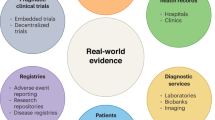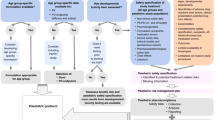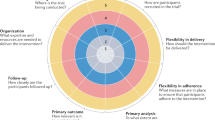Abstract
Historically, the USA and European countries have been the dominant figures in medical research. However, in the past 10 years, Asia has emerged as a new 'hot spot' for clinical research owing to the tremendous potential generated by steady economic growth, remarkable advances in research and development capacity, and an expanding population. However, investigators involved with the set-up and conduct of multicentre trials in such a vast and heterogeneous continent face huge challenges—bridging the fundamental differences between the Asian countries, such as languages, resources, regulatory procedural timelines, and the general understanding of clinical research. In this Perspectives article, we explain why Asia should be established as a hub for large multicentre trials, discuss the challenges involved, and highlight the importance of a strong collaborative infrastructure for multiple investigational sites in this culturally diverse continent.
This is a preview of subscription content, access via your institution
Access options
Subscribe to this journal
Receive 12 print issues and online access
$209.00 per year
only $17.42 per issue
Buy this article
- Purchase on Springer Link
- Instant access to full article PDF
Prices may be subject to local taxes which are calculated during checkout


Similar content being viewed by others
References
WHO. Health statistics and health information systems. Disease and injury regional estimates. Cause-specific mortality: regional estimates for 2008 [online], (2011).
Population Reference Bureau. 2012 World Population Data Sheet [online], (2012).
US National Library of Medicine. ClinicalTrials.gov [online], (2013).
Erickson, A. K. Ethnicity puts clinical trials to the test. Nat. Med. 9, 983 (2003).
Berger, J. S. et al. Reporting and representation of race/ethnicity in published randomized trials. Am. Heart J. 158, 742–747 (2009).
Park, I. U. & Taylor, A. L. Race and ethnicity in trials of antihypertensive therapy to prevent cardiovascular outcomes: a systematic review. Ann. Fam. Med. 5, 444–452 (2007).
Alexander, J. H. et al. Apixaban with antiplatelet therapy after acute coronary syndrome. N. Engl. J. Med. 365, 699–708 (2011).
Mega, J. L. et al. Rivaroxaban in patients with a recent acute coronary syndrome. N. Engl. J. Med. 366, 9–19 (2012).
Granger, C. B. et al. Apixaban versus warfarin in patients with atrial fibrillation. N. Engl. J. Med. 365, 981–992 (2011).
Connolly, S. J. et al. Apixaban in patients with atrial fibrillation. N. Engl. J. Med. 364, 806–817 (2011).
Connolly, S. J. et al. Dabigatran versus warfarin in patients with atrial fibrillation. N. Engl. J. Med. 361, 1139–1151 (2009).
Connolly, S. J. et al. Newly identified events in the RE-LY trial. N. Engl. J. Med. 363, 1875–1876 (2010).
Patel, M. R. et al. Rivaroxaban versus warfarin in nonvalvular atrial fibrillation. N. Engl. J. Med. 365, 883–891 (2011).
Ruff, C. T. et al. Evaluation of the novel factor Xa inhibitor edoxaban compared with warfarin in patients with atrial fibrillation: design and rationale for the Effective aNticoaGulation with factor xA next GEneration in Atrial Fibrillation-Thrombolysis In Myocardial Infarction study 48 (ENGAGE AF-TIMI 48). Am. Heart J. 160, 635–641 (2010).
Clinical Trials. Global study to assess the safety and effectiveness of edoxaban (DU-176b) vs standard practice of dosing with warfarin in patients with atrial fibrillation (EngageAFTIMI48) [online], (2013).
Ueshima, H. et al. Cardiovascular disease and risk factors in Asia: a selected review. Circulation 118, 2702–2709 (2008).
Sasayama, S. Heart disease in Asia. Circulation 118, 2669–2671 (2008).
Hong, Y. Burden of cardiovascular disease in Asia: big challenges and ample opportunities for action and making a difference. Clin. Chem. 55, 1450–1452 (2009).
Yusuf, S. et al. Effect of potentially modifiable risk factors associated with myocardial infarction in 52 countries (the INTERHEART study): case–control study. Lancet 364, 937–952 (2004).
Karthikeyan, G. et al. Lipid profile, plasma apolipoproteins, and risk of a first myocardial infarction among Asians: an analysis from the INTERHEART Study. J. Am. Coll. Cardiol. 53, 244–253 (2009).
Bhatt, D. L. et al. International prevalence, recognition, and treatment of cardiovascular risk factors in outpatients with atherothrombosis. JAMA 295, 180–189 (2006).
Goto, S. et al. Risk-factor profile, drug usage and cardiovascular events within a year in patients with and at high risk of atherothrombosis recruited from Asia as compared with those recruited from non-Asian regions: a substudy of the REduction of Atherothrombosis for Continued Health (REACH) registry. Heart Asia 3, 93–98 (2011).
Smith, S. C. Jr et al. Principles for national and regional guidelines on cardiovascular disease prevention: a scientific statement from the World Heart and Stroke Forum. Circulation 109, 3112–3121 (2004).
EMB Professional Committee. China Guideline Clearinghouse (Chinese) [online], (2013).
Academy of Medicine of Malaysia. ClinicalPractice Guidelines [online], (2013).
Philippine Heart Association, Philippine College of Cardiology. Guidelines [online], (2012).
Gupta, R., Guptha, S., Joshi, R. & Xavier, D. Translating evidence into policy for cardiovascular disease control in India. Health Res. Policy Syst. 9, 8 (2011).
Zhao, D. & Hu, D. Barriers to translating EU and US CVD guidelines into practice in China. Nat. Rev. Cardiol. 9, 425–429 (2012).
ACC. CardioSource. Guidelines & Quality Standards [online], (2012).
AHA. Statements & Guidelines [online], (2012).
ESC. Clinical Practice Guidelines [online], (2012).
Ingelman-Sundberg, M., Sim, S. C., Gomez, A. & Rodriguez-Antona, C. Influence of cytochrome P450 polymorphisms on drug therapies: pharmacogenetic, pharmacoepigenetic and clinical aspects. Pharmacol. Ther. 116, 496–526 (2007).
Kim, K., Johnson, J. A. & Derendorf, H. Differences in drug pharmacokinetics between East Asians and Caucasians and the role of genetic polymorphisms. J. Clin. Pharmacol. 44, 1083–1105 (2004).
Johnson, J. A. Ethnic differences in cardiovascular drug response: potential contribution of pharmacogenetics. Circulation 118, 1383–1393 (2008).
Yu, H. C., Chan, T. Y., Critchley, J. A. & Woo, K. S. Factors determining the maintenance dose of warfarin in Chinese patients. QJM 89, 127–135 (1996).
Dang, M. T., Hambleton, J. & Kayser, S. R. The influence of ethnicity on warfarin dosage requirement. Ann. Pharmacother. 39, 1008–1012 (2005).
Yu, C. M., Chan, T. Y., Tsoi, W. C. & Sanderson, J. E. Heparin therapy in the Chinese – lower doses are required. QJM 90, 535–543 (1997).
Hirsh, J. Heparin. N. Engl. J. Med. 22, 1565–1574 (1991).
Hori, M. et al. Efficacy and safety of dabigatran vs. warfarin in patients with atrial fibrillation—sub-analysis in Japanese population in RE-LY trial. Circ. J. 75, 800–805 (2011).
Hori, M. et al. Efficacy and safety of dabigatran versus warfarin in patients with atrial fibrillation: analysis in Asian population in RE-LY trial [abstract S6–4]. Cerebrovasc. Dis. 34 (Suppl. 1), 9 (2012).
Ogawa, S., Shinohara, Y. & Kanmuri, K. Safety and efficacy of the oral direct factor Xa inhibitor apixaban in Japanese patients with non-valvular atrial fibrillation—the ARISTOTLE-J study. Circ. J. 75, 1852–1859 (2011).
Hori, M. et al. Rivaroxaban vs. warfarin in Japanese patients with atrial fibrillation. Circ. J. 76, 2104–2111 (2012).
Japanese Circulation Society Joint Working Group. Guidelines for pharmacotherapy of atrial fibrillation (JCS 2008): digest version. Circ. J. 74, 2479–2500 (2010).
Zhou, H. H., Koshakji, R. P., Silberstein, D. J., Wilkinson, G. R. & Wood, A. J. Racial differences in drug response. Altered sensitivity to and clearance of propranolol in men of Chinese descent as compared with American whites. N. Engl. J. Med. 320, 565–570 (1989).
Hori, M. et al. Low-dose carvedilol improves left ventricular function and reduces cardiovascular hospitalization in Japanese patients with chronic heart failure: the Multicenter Carvedilol Heart Failure Dose Assessment (MUCHA) trial. Am. Heart J. 147, 324–330 (2004).
Bristow, M. R. et al. Carvedilol produces dose-related improvements in left ventricular function and survival in subjects with chronic heart failure. Circulation 94, 2807–2816 (1996).
Ridker, P. M. C-reactive protein: a simple test to help predict risk of heart attack and stroke. Circulation 108, e81–e85 (2003).
Kelley-Hedgepeth, A. et al. Ethnic differences in C-reactive protein concentrations. Clin. Chem. 54, 1027–1037 (2008).
Motiwala, S. R. & Januzzi, J. L. Jr. The role of natriuretic peptides as biomarkers for guiding the management of chronic heart failure. Clin. Pharmacol. Ther. 93, 57–67 (2013).
McMurray, J. J. et al. ESC Guidelines for the diagnosis and treatment of acute and chronic heart failure 2012. Eur. Heart J. 33, 1787–1847 (2012).
Shi, X., Xu, G., Xia, T., Song, Y. & Lin, Q. N-terminal-pro-B-type natriuretic peptide (NT-proBNP): reference range for Chinese apparently healthy people and clinical performance in Chinese elderly patients with heart failure. Clin. Chim. Acta 360, 122–127 (2005).
Lee, K. H. et al. N-terminal pro-B-type natriuretic peptide levels in the Korean general population. Korean Circ. J. 40, 645–650 (2010).
Macfarlane, P. W., McLaughlin, S. C., Devine, B. & Yang, T. F. Effects of age, sex, and race on ECG interval measurements. J. Electrocardiol. 27 (Suppl.), 14–19 (1994).
Wu, J. et al. Normal limits of the electrocardiogram in Chinese subjects. Int. J. Cardiol. 87, 37–51 (2003).
Leung, N. K. Echocardiographic values for cardiac dimensions and left ventricular mass of normal Chinese adults: a pilot study. J. Diagn. Med. Sonog. 25, 300–309 (2009).
Chen, C. Y., Chiang, B. N. & Macfarlane, P. W. Normal limits of the electrocardiogram in a Chinese population. J. Electrocardiol. 22, 1–15 (1989).
WHO Expert Consultation. Appropriate body-mass index for Asian populations and its implications for policy and intervention strategies. Lancet 363, 157–163 (2004).
Razak, F. et al. Defining obesity cut points in a multiethnic population. Circulation 115, 2111–2118 (2007).
James, W. P., Chunming, C. & Inoue, S. Appropriate Asian body mass indices? Obes. Rev. 3, 139 (2002).
Indian Council of Medical Research. National Institute of Nutrition. Dietary Guidelines for Indians: A Manual [online], (2010).
Yu, D. S., Thompson, D. R., Yu, C. M. & Oldridge, N. B. Validation of the Chinese version of the MacNew heart disease health-related quality of life questionnaire. J. Eval. Clin. Pract. 14, 326–335 (2008).
Yu, D. S., Thompson, D. R., Yu, C. M. & Oldridge, N. B. Assessing HRQL among Chinese patients with coronary heart disease: angina, myocardial infarction and heart failure. Int. J. Cardiol. 131, 384–394 (2009).
Thompson, D. R., Oldridge, N. B., Yu, D. S. & Yu, C. M. Translation and validation of two Chinese health-related quality of life instruments in patients with coronary heart disease. Hong Kong Med. J. 15 (Suppl. 2), 8–11 (2009).
Chan, E., Tan, M., Xin, J., Sudarsanam, S. & Johnson, D. E. Interactions between traditional Chinese medicines and Western therapeutics. Curr. Opin. Drug Discov. Devel. 13, 50–65 (2010).
Holbrook, A. M. et al. Systematic overview of warfarin and its drug and food interactions. Arch. Intern. Med. 165, 1095–1106 (2005).
Cheng, T. O. Cardiovascular effects of Danshen. Int. J. Cardiol. 121, 9–22 (2007).
Louisa, M., Takeuchi, M., Setiabudy, R., Nafrialdi & Takeuchi, M. Current status of phase I clinical trials in Asia: an academic perspectives. Acta Med. Indones. 44, 71–77 (2012).
Wong, E. Clinical trials in Southeast Asia: an update. Drug Inf. J. 43, 57–61 (2009).
Maiti, R., Raghavendra, M. Clinical trials in India. Pharmacol. Res. 56, 1–10 (2007).
State Food and Drug Administration, P. R. China. Regulatory Guide. Drug registration: application and approval procedure for clinical trials [online], (2013).
Ichimaru, K., Toyoshima, S. & Uyama, Y. Effective global drug development strategy for obtaining regulatory approval in Japan in the context of ethnicity-related drug response factors. Clin. Pharmacol. Ther. 87, 362–366 (2010).
Pharmaceuticals and Medical Devices Agency, Japan. Drug and Medical Device Reviews. Profile of Services 2012–2013 [online], (2013).
Schulz, K. F. et al. CONSORT 2010 statement: updated guidelines for reporting parallel group randomized trials. Ann. Intern. Med. 152, 726–732 (2010).
Zhang, D. et al. An assessment of the quality of randomised controlled trials conducted in China. Trials 9, 22 (2008).
Uetani, K., Nakayama, T., Ikai, H., Yonemoto, N. & Moher, D. Quality of reports on randomized controlled trials conducted in Japan: evaluation of adherence to the CONSORT statement. Intern. Med. 48, 307–313 (2009).
Qiu, Y., Xu, H. & Shi, D. Traditional Chinese herbal products for coronary heart disease: an overview of Cochrane reviews. Evid. Based Complement. Alternat. Med. 2012, 417387 (2012).
Moher, D., Jones, A., Lepage, L. & CONSORT Group (Consolidated Standards for Reporting of Trials). Use of the CONSORT statement and quality of reports of randomised trials: a comparative before-and-after evaluation. JAMA 285, 1992–1995 (2001).
Li, X. Q. et al. Endorsement of the CONSORT statement by high-impact medical journals in China: a survey of instructions for authors and published papers. PLoS ONE 7, e30683 (2012).
WHO. International Clinical Trials Registry Platform (ICTRP). Data Providers [online], (2013).
WHO. Noncommunicable diseases and mental health. Noncommunicable diseases country profiles 2011 [online], (2011).
Author information
Authors and Affiliations
Contributions
Both authors researched data and discussed the content of the article, and wrote the manuscript. C.-M. Yu reviewed and edited the article before submission.
Corresponding author
Ethics declarations
Competing interests
The authors declare no competing financial interests.
Rights and permissions
About this article
Cite this article
Kwong, J., Yu, CM. The need for multicentre cardiovascular clinical trials in Asia. Nat Rev Cardiol 10, 355–362 (2013). https://doi.org/10.1038/nrcardio.2013.49
Published:
Issue Date:
DOI: https://doi.org/10.1038/nrcardio.2013.49
This article is cited by
-
Federated learning for multi-center imaging diagnostics: a simulation study in cardiovascular disease
Scientific Reports (2022)
-
Independent Predictors of Cardiac Mortality and Hospitalization for Heart Failure in a Multi-Ethnic Asian ST-segment Elevation Myocardial Infarction Population Treated by Primary Percutaneous Coronary Intervention
Scientific Reports (2019)
-
Bleeding events and associated factors in a cohort of adult patients taking warfarin in Sarawak, Malaysia
Journal of Thrombosis and Thrombolysis (2014)



